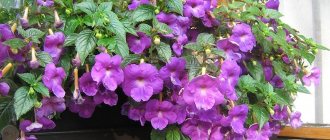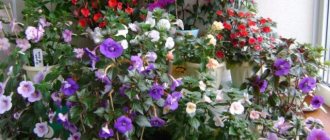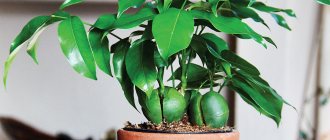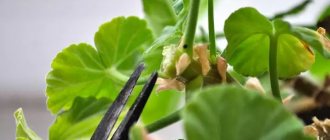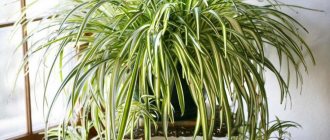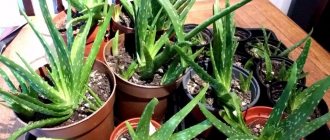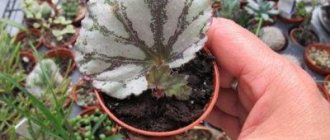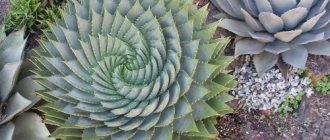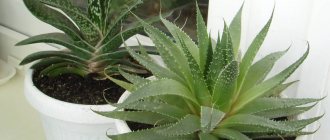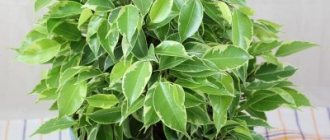Hidden text
Family: Gesneriaceae. Homeland: Central and tropical America. Flowering: from June to October, depending on the species. Height: average. Light: bright diffused without direct sunlight. Temperature: in summer the optimum is within 20-24°C, but not lower than 20°C; in winter, pots with tubers are kept at a temperature of 10-16°C. Watering: plentiful in summer, but the substrate should not be waterlogged, but not too dry. In winter (rest period), the substrate should be moderately moist. Air humidity: high; when spraying, avoid getting water on the leaves and flowers. Feeding: 1 month after the emergence of shoots and until the end of flowering, once every two weeks with a full range of mineral fertilizers. Dormant period: after the end of flowering and after the ground part has dried out, the soil is moderately moist, pots with rhizomes are kept in a dark and cool place, 10-16°C. Transplantation: in the first ten days of February, the rhizomes are planted in the substrate. Reproduction: seeds, rhizomes, cuttings.
Achimenes love a lot of light, but in summer they need light shading from direct sunlight. Lighting requirements may vary depending on the variety. Plants with luxuriously colored foliage require moderate lighting, while those with dark young foliage require more intense lighting. With a lack of light, the stems become bare and quickly stretch, and the flowers become smaller. They do not tolerate drafts and excessive dry air. For normal development and abundant flowering, plants need warm conditions in summer, the optimal temperature is 20-25°C, not lower than 20°C, with high air humidity. After flowering, all nutrients are taken from the leaves and rhizomes (tubers) and accumulated.
By autumn, flowering ends, its leaves begin to turn yellow and die, and the plant enters the dormant stage. It is necessary to prepare the plant for this period and gradually reduce watering until it stops completely. When the ground part dries out, it is cut off. The rhizomes can be left in the same container or transferred to the sand. At the same time, they are stored in a dark and cool place all winter at a temperature of 14-16°C, occasionally moisturizing. Moisten as the substrate dries, carefully watering the edges of the pot with water at room temperature, no more than once a month. Overwatering during the dormant season can cause the plant to go out of dormancy. As a result, the plant will be weakened and flowering will be weak, since in winter there is not enough light for Achimenes to grow and flower successfully. If for some reason your achimenes have come out of the dormant period, you can create additional illumination for them using fluorescent lamps, placing them above the plant at a distance of 30-50 cm. At the end of February, the rhizomes are removed and planted in the substrate; after planting, the pots are transferred to a room with a temperature of at least 16°C is evenly moistened, the plants germinate quickly.
In the spring, when growth resumes, they are watered abundantly, but without stagnating water in the pan. The substrate should not be excessively waterlogged, but in no case too dry. It is preferable to water from a tray; when watering from above, do not allow moisture to get on the leaves, as this causes them to lose their decorative appearance. By autumn, watering is reduced, and after the leaves dry out and the plant goes into a dormant period, only occasionally moisten the soil.
Achimenes prefer high air humidity. When spraying, it is sprayed next to the plant, while avoiding moisture on the plant itself, as this causes dark spots to appear, which impairs the decorative appearance of the plant. The best way to increase humidity is to place the pot on a tray with damp moss, peat, expanded clay, and pebbles.
Achimenes are fed a month after shoots appear and before flowering ends. Plants respond well to feeding with a solution of a complete mineral mixture (1.5 g of nitrogen, 1 g of phosphorus and 0.5 g of potassium fertilizers per 3 liters of water), which should be done every two weeks.
Description of Achimenes
Achimenes is a herbaceous perennial plant. No more than 30 cm in height. The stems are fleshy, branched, dark green or red. At first they grow upward, but droop with age. The rhizome is aboveground with rhizomes (tubers) covered with small scales. They accumulate useful substances that the plant will use after leaving winter dormancy.
The oblong leaves on petioles with a sharp end on the outside are smooth and shiny. They come in dark green, pink, and purple with raised veins. There are small hairs from the inner area of the plate.
At the end of spring, many flowers begin to form in the axils of the leaves along the entire length of the stem. Each corolla has a tube and 5 strongly bent, double or simple petals, separated along the edges.
Reddish, pink, yellow, snow-white, purple flowers are arranged singly or in groups of 3-6 pieces. They reach 3-6 cm in diameter. Flowering occurs until the end of September. When grown at home, it can be observed twice.
Achimenes
We share our experience in growing representatives of the Gesneriaceae family (Violets, Streptocarpus, Episcia, etc.)
- Go to page:
Achimenes
Post by GZ » Sat Apr 14, 2012 16:08
For more than 15 years, this plant from the Gesneriaceae family has been growing and blooming profusely with beautiful large purple flowers. It came to us under the name “Friendly Family”; we learned its real name, “Achimenes”, relatively recently. We also learned that over the century and a half history of cultivation, about 500 varieties of Achimenes and several intergeneric hybrids have already been bred. It seems that our purple Achimenes also turned out to be a varietal one. After lengthy searches on the Internet, comparisons using photographs, descriptions of varietal characteristics and the date of breeding, we identified our “Friendly Family” as Achimenes “Purple King” (1936). However, this name is only conditionally applicable to our Achimenes, since there are other varieties very similar to Achimenes “Purple King”, such as “Pulcherrima”, “Belinda” and “Sterntaler”.
Added after 2 minutes 25 seconds:
All Achimenes are very unpretentious in their maintenance. Only some varieties can be capricious and require special conditions.
The substrate needed for achimenes is the same as for violets. In general, any soil is suitable, the main requirement is that the soil must be light, loose and nutritious, absorb moisture well and be sufficiently “air-intensive”. For our plants, we make the substrate ourselves from a mixture of rich garden peat soil, compost humus, peat and manure humus (approximately 3:1:1:1). It is also good to add coarse river sand and/or vermiculite. Perlite is also good as a leavening agent, but we have never used it before as it is simply not available in our flower shops.
Added after 3 minutes 21 seconds:
Lighting. Achimenes is considered light-loving. The best location is western and eastern windows and loggias. On windows facing south it may require shading, and on windows facing north, on the contrary, additional lighting. But these are very conditional recommendations! Achimenes adapts quite easily to any conditions, puts up with many “hardships” and, having got used to a permanent place, will delight its owners with flowering. Our Achimenes feel good in a bright northern window and bloom readily. What is definitely not suitable for them is complete shade, a location far from the window, in the back of the room (without additional lighting). This makes them very stretchy and almost never bloom. They are also not comfortable in the open, constant sun, the color of the leaves and flowers “fades.” The plant can get sunburn, and in the heat, over +30 degrees, it can simply wither, even if the earthen lump in the pot is sufficiently moist.
Added after 1 minute 48 seconds:
Watering. From the moment the rhizome is planted until flowering, watering is very moderate, as the top layer of soil dries slightly and without stagnation of water in the pan. When flowering becomes abundant, the plant turns into a small pump and becomes a water drinker. You have to water it every day and a lot. In the fall, when flowering begins to decline and the plant begins to gradually die, preparing for hibernation, watering should be significantly reduced. When the plant wilts halfway, stop watering altogether.
Growing Achimenes from rhizomes
I would like to share my experience of growing Achimenes from rhizomes. Rhizomes are rhizomes, which are modified shoots and form mainly in the soil.
At the beginning of March 2022, a neighbor shared with me rhizomes of Achimenes (12 pieces) - 4 varieties.
Rhizomes
She didn’t know the names of the varieties, she just said that the flowers should be white, yellow, red and orange. I had never heard of this flower, so I had to fill in the gaps in my floriculture education - the Internet to help and forward...
Firstly, it turned out that during the winter the entire above-ground part of the plant dies off and comes to life only in the spring. This is interesting because I have a preference for houseplants that don't undergo significant winter dormancy. But there's always a first time for everything. Secondly, thirdly, etc. you can read further.
Ads by
When and how to plant
It is recommended to wait until the rhizomes “awaken,” that is, until they grow white sprouts.
Until this point, rhizomes should be stored in sealed bags (without substrate). Therefore, I placed my rhizomes in plastic bags and began to wait. My patience ran out on March 12 (not a single hint of sprouts) and I decided to plant them. For this:
- I took a small container and filled it with a universal soil mixture for flower and vegetable seedlings.
- The soil was moistened, the rhizomes were arranged at a distance of 2 cm from each other and sprinkled with soil (height 1 cm).
- I covered the container with a bag, although I then read that this could lead to excessive moisture and rotting of the rhizomes. But I periodically ventilated the plantings and shook off the condensation.
Shoots of Achimenes, photo taken on March 28.
Everything sprouted safely from March 21 to 24.
Caring for Achimenes seedlings
After the sprouts appeared, I removed the cover and moved the container from the west window to the east.
The seedlings developed quite quickly. These are the achimenes that grew by April 24. Watered as needed, without drying out the soil. But the soil should always be slightly moist.
Pinching promotes the growth of side shoots
To form lush bushes, it is recommended to pinch 3-4 times over the second or third pair of leaves. I made two pinches. At the same time, the cut off tops take root easily: they can be buried in the ground and covered with film, but I decided not to bother and buried them in the same container (everything took root well: both the tops and one leaf).
The tops and leaves take root very well
The optimal temperature for growth is +23°C, sun protection and bright, diffused lighting are required. By the end of April, my achimenes were ready to transplant, but all the window sills were filled with seedlings, so I had to wait until mid-May.
Transplantation into separate containers
I started transplanting on May 11, the Achimenes have stretched out, but not critically.
My achimenes May 1
What to pay attention to
It is better to choose wide and shallow planting containers.
The soil should be nutritious and loose; ready-made soil for Saintpaulias is also suitable. I preferred this container (it is wide, shallow and long) and decided to transplant all my achimenes into it. I planted all my achimenes in this container.
I had soil for orchids available, I added humus and coarse river sand to it. There were no problems with the transplantation: I carefully removed the achimenes and separated the roots; I made depressions in the ground and placed the achimenes in them, watered them and covered them with soil. She shaded them for three days. And a few days later flower stalks appeared! I'm waiting for it to bloom.
These are the flower stalks that grew by May 26
Since the soil in which I planted the achimenes was quite “charged” with humus, I decided not to feed them this season. That's all for now. But I will definitely talk about how my achimenes is developing.
Rhizomes are different!
This is what Achimenes planting material looks like. These are rhizomes. Different varieties have different shapes of “earrings”. When is the best time to plant them? If you do not have the opportunity to provide additional lighting to the plants, it is better to postpone planting until March. If rhizomes begin to sprout during storage, you need to lower the temperature to +5...+8 o C - the sprouts will freeze and will not stretch. To do this, we place the rhizoms in the refrigerator in the fruit drawer and check them regularly. Temperature - not lower than +5 o C. It is better to plant sprouted rhizomes, since dormant rhizomes have a risk of rotting when watered. The best time for planting is February-March.
If you have the conditions for early planting, remove the planting material from the refrigerator. Rhizomes can feel the spring and germinate as early as the end of December. Then you can plant them. But I make sure to keep such early plantings under lighting, otherwise the plants will stretch out due to lack of lighting, and in the end we will get weak flowering and an unattractive bush.
Planting process
At first I choose small pots for Achimenes in order to save space, but as the plant grows, at the end of April-May I transfer it to a larger, 1.5-2-liter pot, since in a small container the flowering will be worse and the “harvest” of the rhizome will be small . I don’t plant more than 4 plants in a pot; one rhizome requires a soil volume of at least 0.8 liters. Then I plant 4 plants in a 2-liter pot. It is advisable to choose wide pots, since the root system of the plant is superficial.
I put drainage at the bottom of the pot so that there is no stagnation of moisture. I use sphagnum moss in a layer of 2-3 cm. You can fill in expanded clay, broken pieces of polystyrene foam, or not use it at all if you do not have a tendency to flood plants.
For successful growth, achimenes need light, nutritious soil based on peat (as for violets). I add 1/3 of horse humus to it, but this is not necessary.
The rhizomes need to be laid out horizontally and sprinkled with 0.5-1.5 cm of soil. The smaller the rhizome, the smaller the depth. We do not cover the rhizomes with film; the optimal temperature for germination is from +18 o C to +25 o C.
We don’t water the pot with planted rhizomes, but spray it a little from a spray bottle and place it under lighting or in a sunny window. Since the rhizomes do not yet have roots, they may rot. Water sparingly until shoots emerge. Over time, when the bush and root system begin to grow, we increase watering, but wait until the soil dries out between waterings. In the summer heat, we will water abundantly and every day.
Achimenes varieties
Popular varieties:
| Name | Stem (shoots) | Flowers | Bud opening period |
| White | Straight, with green or red shoots. | Small, 1-1.5 cm. The outside has the color of baked milk, reddish on the inside. The corolla tube is yellow with scarlet stripes. | Summer. |
| Ehrenberg | Erect, heavily pubescent and leafy. Regular pinching is required. | Medium, lilac color on the outside, which smoothly turns into pinkish on the back. The pharynx (corolla tube) is bright yellow with pink speckles. | Summer autumn. |
| Prostrate | Grows upward, brown, less often green. | Pink-violet, up to 2 cm. | June August. |
| Erect | Vertical, medium height, reddish in color. | Scarlet, small, up to 1 cm. | |
| Mexican | Strongly branching, grown as an hanging plant. | Up to 3.5 cm, lilac, purple or pinkish with a snow-white tube. | Summer autumn. |
| Variegated | Reddish, erect. | Burgundy, large, up to 5 cm. The throat is yellow with spots, widened towards the end. | |
| Long-flowered | Lodging, pubescent, weakly branched, up to 10-30 cm. | Large, up to 6.5 cm. Blue, pink, gray-purple with a yellow or snow-white tube. | |
| Fringed | Drooping, up to 30 cm in length. | Up to 2 cm, white, with fringe along the edges. | |
| Nocturne | The shoots are hanging, grown as an hanging plant. | Large, up to 4.5 cm. Terry, velvety, dark burgundy on the outside, lighter on the inside. | Summer. |
| Sabrina | At first they grow vertically, but eventually droop. | Coral pink with a yellow tube. Small, up to 2 cm. | Summer autumn. |
Subtleties of pinching and pinching
And now - the most interesting part. How to form a bush so that during flowering you can’t take your eyes off it. At the very early stages of Achimenes growth, we begin to form the plant by pinching it.
When the plant grows 2-3 pairs of leaves, we remove the crown with nail scissors - this is tweezing. We don’t throw away the tops - they, along with the rhizome plants, will give rise to new bushes and will have time to grow a bush no smaller than the rhizome plants. Propagation by pincer crowns is an easy and reliable way to propagate Achimenes.
In a small plastic cup with drainage (you can break the foam) and soil, we place these tops the size of a match head.
We press the tops of the heads a little into the ground, lightly spray them with a spray bottle, put them in a zip-lock bag and place them under additional lighting. After 10 days, the cuttings grow - this is a sign of rooting.
After 10 days, the plant whose crown was pinched already produces two shoots, but in general there can be 3 or even 4. We repeat pinching. These tops can also be rooted. So I pinch the plant from 4 to 7 times until the buds appear.
Here are the formed achimenes, ready to bloom
The pinning, of course, will delay flowering by a week or a week and a half, sometimes by 20 days, but then it will be so gorgeous, you will understand that it is worth it!
I pinch all varieties indiscriminately. The only variety, Ambroise Vershaffelt, does not bush well after pinching; it does not need to be pinched.
Achimenes from one rhizome
From one rhizome it is not at all difficult to grow a gorgeous flowering achimenes. We remove the crown of the emerging sprout with nail scissors so that the plant does not tend to grow into one stem and forms a fluffy bush.
We plant the top of the head in the same pot, pressing it slightly to the ground, cover it with cling film, and make small holes in it for air exchange.
We send the pot under lighting. A greenhouse effect is formed under the film, which contributes to the rapid rooting of the pincer crown.
When the cutting takes root, we remove the film, but it’s still a little early to tweezing and pinching. A little later, we’ll cut off the tops of both sprouts and plant them in the same pot.
Feeding schedule
It is imperative to feed Achimenes once a week. You can use any fertilizer and alternate them. Fertilizers should be diluted strictly according to the instructions; it is even better to make the solution a little weaker to avoid burns.
Pre-watered plants need to be fed. If the soil is dry, you must first water it with clean water and when the plant has drunk, only then feed it.
Sources:
https://forum-flower.ru/showthread.php?t=562 https://www.floriculture.ru/forum/viewtopic.php?t=1899&start=80 https://www.greeninfo.ru/indoor_plants/ achimenes/kak-sazhat-akhimenesy-chtoby-poluchit-shikarnye-kustiki_art.html
Diseases and pests of Achimenes
When properly maintained, the plant is rarely affected by diseases and insect pests. In the absence of optimal conditions for development, Achimenes may experience the following problems:
| Manifestation | Cause | Corrective measures |
| The foliage turns yellow and becomes smaller. Deformation of the buds and plates occurs. | Chlorosis due to hard water. |
|
| Light, round spots appear, which turn brown over time. | Ring spotting due to cold watering, drafts, and direct sunlight. | It is impossible to cure the disease. To prevent its spread you need to:
|
| The greenery turns brown and falls. A grayish coating is visible on the plates. | Gray rot as a result of high humidity, cold temperature. |
|
| Small (up to 0.5 mm), red insects are visible on the reverse side of the leaf blade. Microscopic cobwebs, yellow spots and dots appear on the greenery, turning brown over time. | Red spider mite. The insect loves dry, warm air. | Apply medications:
Neighboring plants also need to be treated. Repeat the procedure 3 times, with an interval of 7 days. |
| The plates are twisted into a tube, deformation of leaves, flowers, and shoots occurs. You can see small, black or green insects on the bush. | Aphid. | Use chemicals:
|
| The formation of a white waxy coating on the plant, fluffy lumps similar to cotton wool. | Mealybug (hairy louse). |
|
